iMovR Stowaway Keyboard Tray Review
- Lab tested
Like most reviews sites, our editorial staff and laboratory testing expenses are partially offset by earning small commissions (at no cost to you) when you purchase something through those links. Learn More

Overview
| Review Summary |
The Stowaway does everything a keyboard tray needs to, does it well, and comes in at a surprisingly low street price. A wide range of height adjustment is complemented by removable gel/foam wrist pads (perfect for accommodating ergonomic keyboards). 15º of negative tilt is an industry-standard for adjustable trays, and the Stowaway adds 5º to that. Anyone looking for more extreme tilt angles, like treadmill desk users, will be better served by something like the SteadyType Exo. |
|---|---|
| MSRP / List Price | $275 |
| Street Price |
iMovR currently has an exclusive offer for WorkWhileWalking readers going on! Get 15% off everything in your cart with the coupon code WWW15. |
| Shipping |
Free |
| Warranty |
Lifetime |
| Construction |
Made in the USA |
| Adjustment Range |
Total height adjustment of 8.8″(+2.38″-6.5″) |
| Competition |
Top-Rated Ergonomic Keyboard Tray Reviews
|
| Where to buy |
Buy on iMovR |
Rating
| Stability | |
|---|---|
| Reliability | |
| Customer Experience | |
| Quality and Aesthetics | |
| Ergonomics | |
| Innovation | |
| Value | |
| Suitability for Treadmill Desking | |
| Positives | iMovR's innovative, American-made Stowaway adjustable keyboard tray marries functionality with easy installation (only bested by the SteadyType Exo). It offers a solid solution to the problem of how to add an ergonomic keyboard tray to a standing desk when there's a crossbar in the way, as there is on 99% of height-adjustable desks. The Stowaway's 21.75” rail is designed to line up with pre-drilled pilot holes on the iMovR Freedom Line Desks (the Energize and Cascade), but can be used with any standing desk—you just have to pre-drill the screw holes yourself using the glide track as a template, per the video instructions. |
| Negatives | Like all underdesk keyboard trays, when attached to a two-legged adjustable-height desk there will always be some shake. We always recommend using an iMovR desk with built-in SteadyType, or the SteadyType Exo keyboard tray, if you're planning to add an underdesk treadmill to your workstation. |
Bottom Line
A Keyboard Tray For Your Stand Up Desk
Any decent keyboard tray fixes two common ergonomic woes. Wrist extension (bending the wrists too far back toward the forearm) and elbow flexion (holding the elbows at too sharp an angle). Negative tilt helps with the former, while vertical height adjustment helps with the latter.
iMovR’s Stowaway keyboard tray passes both requirements with flying colors because it is designed for the ergodynamics of standing desks and treadmill desks. While the industry standard for negative tilt is 15º, the Stowaway goes the extra mile (well, 5º) and can be adjusted to negative 20º of tilt. This seemingly minor fix can do wonders for your wrists, as a few extra degrees allow a typist to keep his or her hands in a comfortable, neutral position.
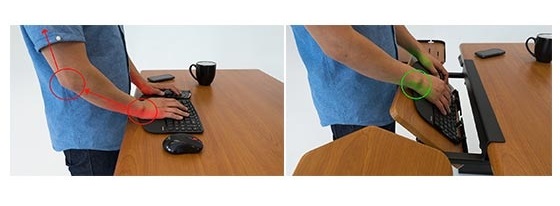
Negative tilt is perhaps the single most important concept that users, and even salespeople and websites that sell keyboard trays, get reversed in their minds, and it’s easy to understand why this happens. The very word “negative” sounds counter-intuitive. But, in fact, it’s a negative tilt, as shown in the photo on the right, above, that you want to achieve with an ergonomic keyboard tray. The only application for positive tilt is typically for gamers who want to lean way back in their chairs and still be able to see and reach their keyboards.
In general, keyboard trays allow you to tilt the edge of your keyboard that’s closest to the user up, bringing it into a negatively-inclined position from the perspective of where your wrists are resting on the user edge of the keyboard. While this may depart from old-school, pre-ergonomic keyboard design (pop-up tabs on many keyboards used to let you elevate the back—a humongous ergonomic no-no) it’s actually ergonomically proper to tilt the keyboard the other way.
It’s only by placing the keyboard at a negative tilt that wrist flexion—and consequent squeezing of the carpal bones that surround the nerves and blood vessels that pass through them—can be neutralized. If you’re using a treadmill desk, you’ll need to get even more negative tilt than while standing (In the treadmill case, we actually recommend the SteadyType Exo or any desk with SteadyType technology. With its rock-solid stability and 360º of tilt, the Exo is the perfect device for treadmill desks). We’ve never been able to figure out how the computer industry started down this path of tilting keyboards in exactly the opposite direction as is ergonomically correct; the myth has persisted for decades and millions of computer users are still unaware.
The Stowaway shines in terms of vertical height adjustment. Most similar products bring around 6” of height adjustment—iMovR’s closest competitor quality-wise, Humanscale, manufactures an arm with 7” of adjustment. The Stowaway is capable of 8.8” inches of vertical adjustment, the best we’ve seen from a standard keyboard tray arm. With such a sweeping range of adjustments, the Stowaway can actually reach above the desk surface. For very tall individuals whose adjustable height desks just don’t reach high enough for ergonomic comfort this added height can be a real blessing.
The Stowaway’s lever-locking system is easy to use and holds fast in any position. Lifting the front of the board allows a user to vertically adjust the tray arm while lowering it locks the Stowaway firmly in place. A handy knob controls negative tilt (the Stowaway can also adjust to 10º of positive inclination, a good option for users who prefer to work in a reclined position). All of these adjustments are tracked by a small grid on the front of the tray arm. We love this feature–yes, partly because it looks cool (it was instantly dubbed the “battleship board”), but also because it makes tracking and remembering your favorite positions much, much easier.
use and holds fast in any position. Lifting the front of the board allows a user to vertically adjust the tray arm while lowering it locks the Stowaway firmly in place. A handy knob controls negative tilt (the Stowaway can also adjust to 10º of positive inclination, a good option for users who prefer to work in a reclined position). All of these adjustments are tracked by a small grid on the front of the tray arm. We love this feature–yes, partly because it looks cool (it was instantly dubbed the “battleship board”), but also because it makes tracking and remembering your favorite positions much, much easier.
Peripheral Friendly
Most adjustable keyboard trays come in one of two shapes. “Big board” options are exactly what they sound like, and are designed to accommodate keyboard and mouse side by side. The other option comes with a smaller keyboard platform and an attached mouse tray.
The second design carries a few advantages. The mouse platform can swivel around from any position on the left or right edges of the keyboard tray, allowing you to bring your mouse closer to your body (eliminating reach is ergonomically beneficial). What’s more, the platform also has a couple of inches of independent height adjustment, and independent tilt adjustment—both of which are really handy features, as the best location for your keyboard isn’t necessarily the best for your mouse. Those of you with Microsoft Natural ergonomic keyboards, or similar products, also have the option of removing the leather-like foam-filled palm rest and using your board’s built-in rests instead.
Simple Installation
iMovR built their tops with the Stowaway in mind, 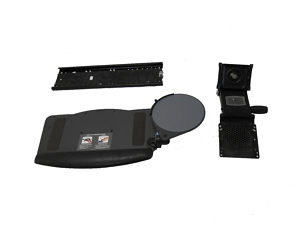 and we would be remiss if we didn’t talk about the predrilled holes for keyboard tray installation that come standard with any ThermoDesk top. These pilot holes made placing and installing the tray enormously easier and faster. All trays we’ve seen before had to be carefully positioned and installed—a process we all quickly learned to dislike here at the office. No one really likes guddling about with templates, drill bits, and tape measures—something that iMovR mercifully took to heart. Pilot holes cut installation time in half, by making it a simple matter of lining up the rail and screwing it in.
and we would be remiss if we didn’t talk about the predrilled holes for keyboard tray installation that come standard with any ThermoDesk top. These pilot holes made placing and installing the tray enormously easier and faster. All trays we’ve seen before had to be carefully positioned and installed—a process we all quickly learned to dislike here at the office. No one really likes guddling about with templates, drill bits, and tape measures—something that iMovR mercifully took to heart. Pilot holes cut installation time in half, by making it a simple matter of lining up the rail and screwing it in.
The 21.75″ rail of the Stowaway is meant to be installed horizontally along the leading edge of the desk, either flush against the edge (for greater height adjustment) or recessed a couple of inches (to allow a user to stay close to their desk). Horizontal placement helps ensure that a user can find an ergonomic position to work from, and removes some of the stress of getting the rail perfectly placed during installation. While this decision doesn’t allow “roll-away” storage—i.e. sliding the tray under the desk—Stowaway trays can still be tucked away when not in use. A swiveling mechanism makes it possible to swing the arm under the desk, completely hiding it and preventing any bumps from passing coworkers.
This installation is quite easy for an adjustable keyboard tray, but if it still makes you uncomfortable, the SteadyType Exo and its 30-second installation could be a great option.
If you do want to install the Stowaway so you can slide the tray under the desk, you can always use iMovR’s keyboard tray adapter kit for standing desks, which allows you to use spacers to install a keyboard tray under the crossbar that essentially all standing desks have. This method of installation is slightly more complicated since you will need to position the assembly where you want it, mark the holes, pre-drill the holes, and then screw it in.
There are the usual words of caution when installing anything that requires you to drill holes in your desk. This method will result in a very secure connection but carries obvious risks, like drilling too far and penetrating the surface of your desktop (if this makes you nervous you can always invest a few dollars in a drill bit with adjustable depth). The wood screws in this spacer kit are less than ¾” which is short enough to not drill through any common desktop surface.
For a more thorough look at installing an adjustable keyboard tray on a standing desk, check out our primer on the subject.
Watch the Video Instructions for Installation an iMovR ThermoTread Stowaway Ergonomic Keyboard Tray:
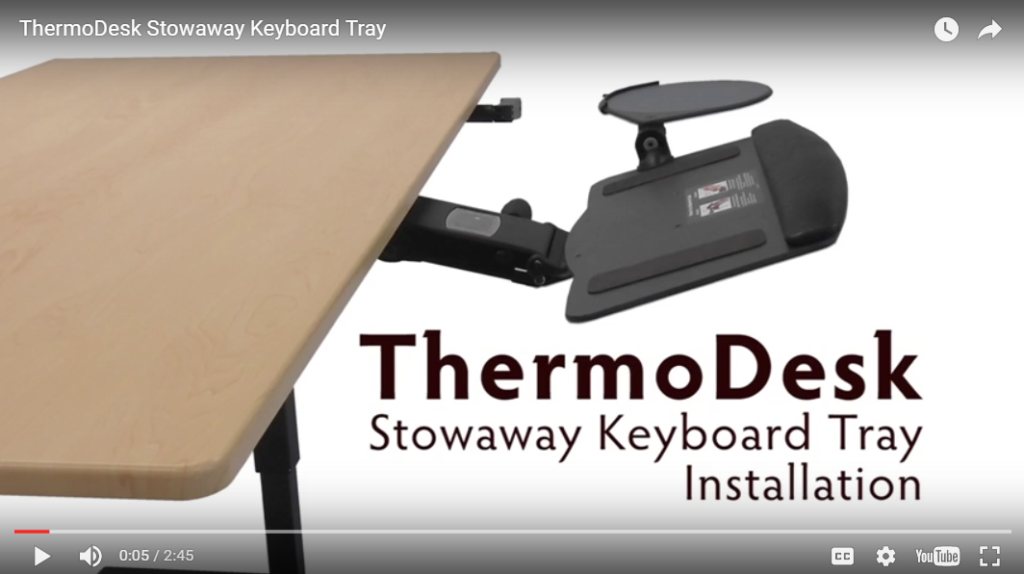
What to do when you want to take a conventional keyboard tray off your old fixed-height desk and transfer it to your new standing desk instead? A common issue that people have when installing keyboard trays on standing desks is being incompatible with the crossbar under adjustable-height desks. iMovR’s Keyboard Tray Standing Desk Adapter Kit offers an easy workaround to this problem without sacrificing any adjustability or stability
Articles About Keyboard Tray Ergonomics That Will Interest You
• How To Avoid Carpal Tunnel Syndrome, Neck Pain And Shoulder Spasms While Typing
• How To Set The Proper Keyboard Tray Height For Maximum Ergonomic Benefits
• Is A Sedentary Desk Job, The Most Dangerous Job In The World?
• What Employers Urgently Need To Know About Kitchen Table Ergonomics

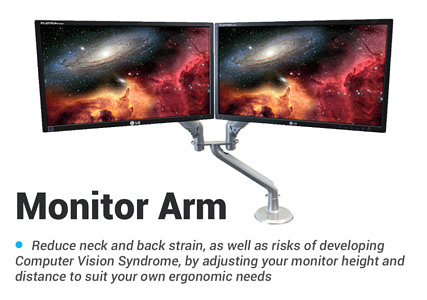
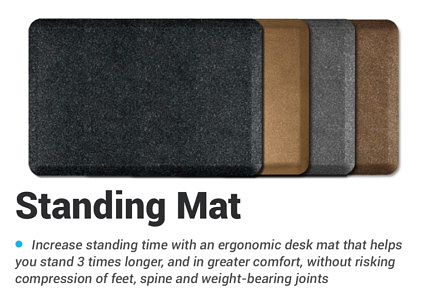
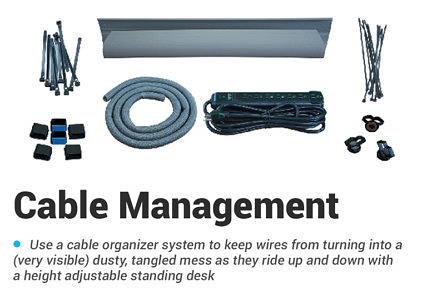
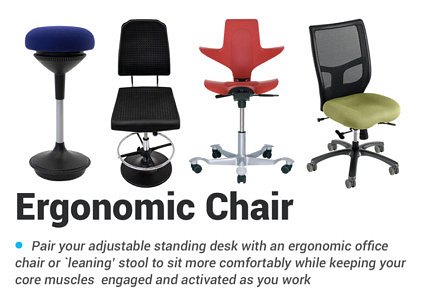
2 Comments
Leave a response >